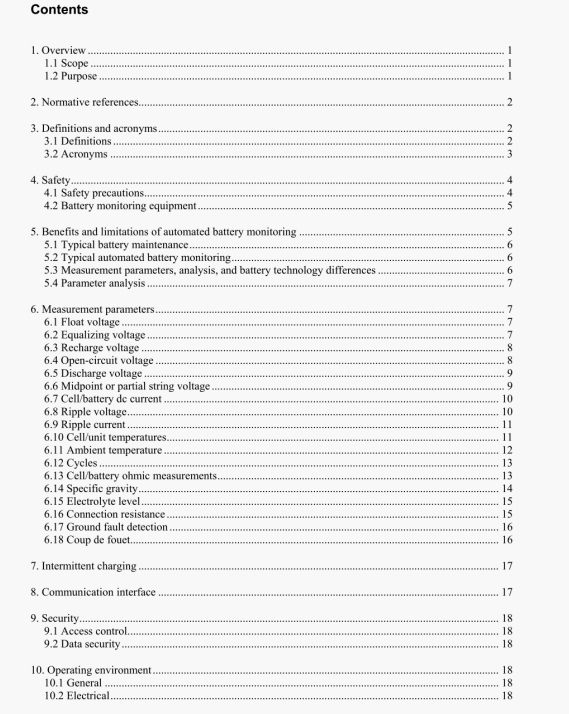IEEE 1491:2012 pdf download.IEEE Guide for Selection and Use of Battery Monitoring Equipment in Stationary Applications.
5.1 Typical battery maintenance
flattery maintenance procedures are defined in other IEEE documents. For example. refer to IEEE Std 450. IEEE Sid I 188. and IEEE SW I 106.
5.2 Typical automated battery monitoring
An advantagc of automated systems is their ability to collect, store, report, andor analyzc data. A distinct advantage of the automatic system is its ability to monitor these parameters continuously. even during a discharge event. provided that the monitoring system is posered from a protected circuit. This information may also allow the user to decrease the frequency of manual collection of sonic parameters of the batlery Reports and results of automatic and manual maintenance inspections need to be rcvewcd and analycd for possible action.
5.3 Measurement parameters, analysis, and battery technology differences
5.3.1 Measurement differences
Primarily two battery technologies acne stationary applications: lead-acid and nickcl-cadmium Whilc all of the parameters described in this clause may be measured for each technology, the significance of those measurements may vary, Battery monitoring systems are most frequently installed with lead.acid bateries. so the information provided for each parameter is specitIc to lead-acid technology. Where applicable. differences for nickel-cadmium tcchnolotjv arc provided.
5.3.2 Parameters
The measurement of any single parameter by itself may not reliably reflect the SOH of a battery.
The following parameters can be monitored periodically at sCt intervals or continuously by a battery monitoring systcm. These parameters can also be used in conjunction with the battery manufacturer’s published data to predict the SOIl and remaining useful battery life.
— Voltage: Cdl, groups of cells. partial string. and battery terminal voltages.
— Current: String, tiont. recharge. and discharge currents arc measured and recorded.
— AC ripple voltage and current: AC components of the string voltage and current axe measured and recorded. In multictring installations, each slnng measurement is made and recorded.
— Temperature: CeILbattery and ambient temperatures are measured and recorded in degrees C or F.
— Interconnection resistance checks: Intercell and battery connections are measured and recorded in microohms,
— Internal ohmic measurement checks: Each cellbattery or cell group is measured for ohmic values.
— Specific gravity: Each cell is measured for its specitic gravity level.
— Electrolyte levels: Each cell is measured for its electrolyte level.
— Coup de fouet: Initial voltage drop and recovery of the battery under load.
IEEE 1491:2012 pdf download
